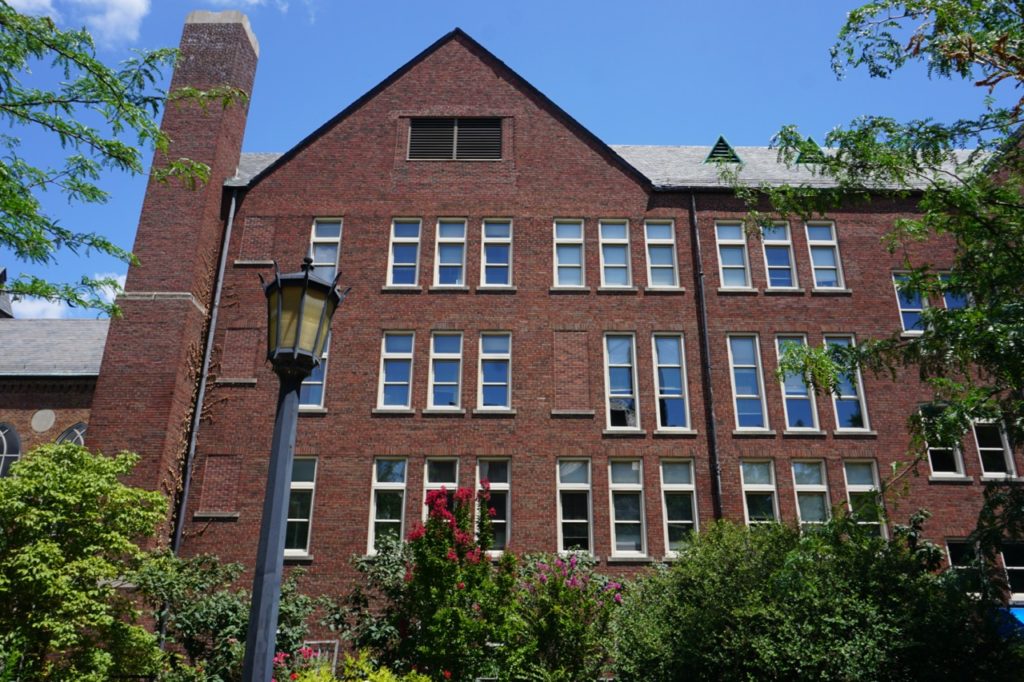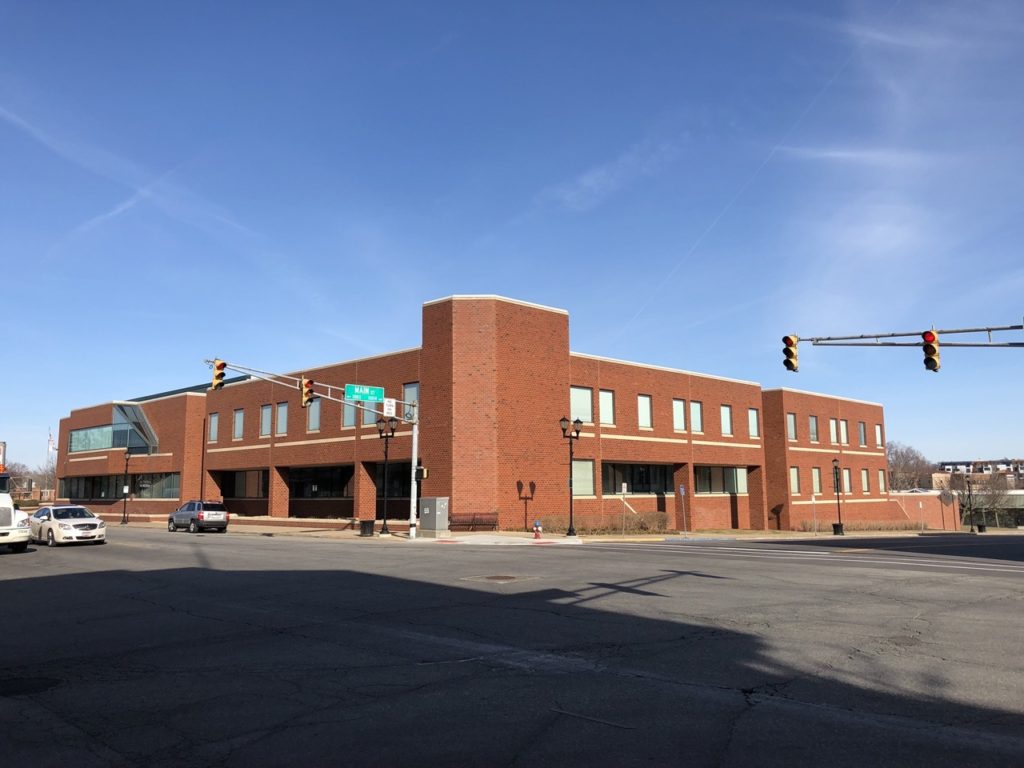Brick Preservation and Restoration: Stain’s Valuable and Long-Lasting Role
Words: Don Foster
Words: Don Foster, President & Co-Founder of Masonry Cosmetics, Inc.
Photos: Masonry Cosmetics, Inc.
Brick buildings come in all sizes. Whether large or small, they are usually considered strong, safe, stable, and durable. Few observers realize, however, that these sturdy structures are in constant motion. As external temperatures change, for example, brick expands when heated and contracts when cooled. And beyond just brick, mortar and many other materials also make up the wall system. As strong as these buildings are, they still need to be maintained. Preservation and restoration can make all the difference for these buildings as they age over time.
Brick and mortar are the two main products that clad a brick building. In most cases, brick will outlast the mortar joint itself, so a crucial part of preserving the building is repointing the mortar as needed. Usually, an entire building will not require repointing. Only designated areas of wear to the mortar need to be addressed. Thankfully, it is simpler to repoint mortar than it is to replace broken brick. And repointing is made easier today by testing for the original mortar used in order to discover just the right mix. Damaged brick is a bigger issue and a more difficult one to resolve, depending on the cause of the damage or the problem it presents.
Cracked brick running down a wall indicates the building may have settled. An engineer’s involvement is necessary to discover a solution, and a restoration project must be planned in detail. What happens if you come across spalling, a shearing off of the surface of, or the disintegration of an area of a building’s brick surface? Again, the discovery of the cause of the spalling is essential, and a solution must be devised and carried out. In the case of a small area of spalling brick, exploration often reveals that the underlying problem is worse than that of cracked brick. Typically, quite a few bricks in the same area will be compromised. Please note that a restoration company cannot always estimate the extent of a problem until they open up the wall area needing remediation.
Today our industry has the best architects, engineers, and restoration and masonry contractors available, and they do some of the most amazing work restoring our aging buildings! Their work is key to our industry's reputation and its claim on the best building product. Surprisingly, our toughest challenge is not the construction phase but the visible aesthetics when a restoration job is complete. This is difficult to achieve sometimes because the materials necessary for a good-looking repair or match are limited by what is available. Several brick plants that produced millions of brick in earlier years are now no longer in operation. Because of this, it is sometimes difficult or impossible to locate an identical brick to use for repairs. Sometimes a brick stain is required, as well. One that withstands the test of time that neither harms nor compromises a brick in any way is needed now more than ever. And with all the misinformation that is out there, selecting the right stain to use requires a deeper dive.
 Before (2000)
Before (2000) After (2022)
After (2022)
Often it is difficult to find a match for historical brick, and I have often witnessed the difficulty of matching mortar, as well. The key to matching the brick is pretty simple and basically follows some common sense rules. First, if the brick is not available, find the closest brick in size and texture. Next, get as close as you can to the base color of the brick. Lastly, mortar plays just as important a role as the brick. If the brick is modular in size (2 1/4" x 7 5/8"), mortar can represent as much as 18 to 20% of the wall area. This will, in turn, have a major effect on the color match. Matching the mortar color, texture, and the type of joint that is on your building will make a tremendous difference in quality and appearance.
The stain product you select for either the brick or mortar is a critical part of long-term performance, and knowledge of the different stain products that are in the marketplace today will be key to the success of a lasting solution. Stay alert for misinformation. A few products that call themselves a proprietary brick stain may only consist of watered-down paint products. While the product may tout great technical data, lab tests, and support information, it may not have long-lasting field performance to support such claims.
Years ago, lab testing was important; many of today’s stain companies did not have jobs or projects back then with enough history to represent their products’ field performance. So they selected a range of tests they hoped would indicate their products' reliability in the long term. Most, if not all of the current stain companies passed those early tests. Today, a better measure of reliability would be to compare these companies’ actual field performances to their long-ago test results. If it is found that earlier test results do not correlate with the current field performance of their former projects, if field performance becomes a burden of ongoing restoration and maintenance, that calls the value of those tests into question. Going forward, the potential damage to brick buildings through the use of improper staining products, especially to our beautiful historic buildings, would be heartbreaking. Staining, applied correctly with the right product, can be successful and greatly rewarding to all involved.
 Before (2021)
Before (2021) After (2022)
After (2022)
There are a few stain companies that have been around for 29 to 34 years, and a few that state a history much longer than that. Some of those, we have found, are a line of painting companies that would have painted the brick on a house vs. calling it a brick stain back then. Those same companies of 29 years or older that offer warranties—for example, 25-year, 50-year, and Lifetime Warranties—should have literally hundreds of jobs they could call up to represent the performance of their products over time. Caution is advised when considering a newer company that has been around only a few years, yet is offering a 50-year warranty. Are there proven tests that could support that claim?
Look carefully at what the warranty says. If you are expecting a company to come back and fix a staining job if it fails, you might find the warranty is not worth the paper it is written on. One recent example of a 25-year warranty says that on a pro-rata rate they offer three options: (1) Refund Product Cost, (2) Refund Product Replacement, or (3) Refund Pro-Rata Rate Credit on the next project. Pay Close Attention!!! Buyer Beware!!! There are NO ASSURANCES that this company will re-stain or fix issues with your brick staining project.
A few stain companies offer Case Studies. These can be misleading depending on what an actual case study represents. For example, does the study consist of a few beautiful pictures with a nice storyline, or does it include before and after pictures from when the project was originally stained. Does the case study continue with follow-up pictures of what the job looks like many years later? Have you been given enough information for the project to be studied? The study can look great on paper, but has anyone actually visited the projects? Case studies lacking evidence are marketing materials. There is truly nothing scholarly or academic about them.
The difference between Brick Paint and Brick Stain, from this writer's point of view, is pretty simple. A Brick Stain should be a translucent-in-nature slurry applied by brush to the absorptive brick, one brick at a time. This stain embeds itself into the pore structure of the brick and, most importantly, allows the straight-from-the manufacturer maintenance-free brick to remain a maintenance-free brick. It can get soaked by the rain, yet dry and ‘breathe’ naturally after it has been stained, just like an unstained brick.
A Brick “Paint-like” stain contains a percentage (any percent) of latex or acrylic, consists of either paint or watered-down paint, and is re-labeled and called a “proprietary brick stain.” This product, once applied, turns a maintenance-free brick into a maintenance one. These watered down paints can be sprayed, rolled, or brushed on, and sometimes all three applications could be used on the same project. Unfortunately, we have seen these “stains” either fade or turn into a chalky whitish film that can compromise the brick, its appearance, and its maintenance for years.

The University of Notre Dame’s “Golden Dome'' Administration Building pictured above is from a Case Study written in 2016, and is a great example of the then 137-year old building. Now 143 years old, its preservation and restoration contribute to its long lasting success all these years. A landmark, and one of the more photographed buildings in the United States, its aesthetic staining plays an important role in its success, and can do so for preservation and restoration projects to come.